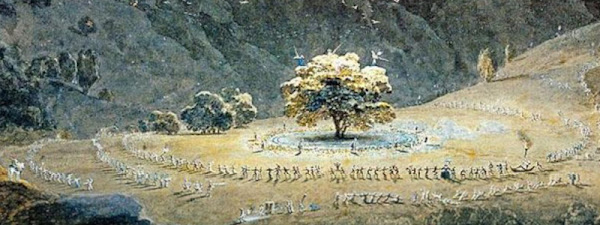«Unguento, unguento, mandame a la noce di Benevento, supra acqua e supra ad vento e supra ad omne maltempo.»
[Ointment, ointment, send me to the walnut tree of Benevento, above water and above wind and above all bad weather.]
— Matteuccia Francesci of Ripabianca (Todi), tried for witchcraft in 1428
In the first chapter of his 1899 book Aradia, or the Gospel of the Witches, Charles Godfrey Leland gave the first published text of what has become known as The Charge of the Goddess — instructions from the goddess Diana to her daughter Aradia the first of all witches — which he translated into English from an Italian manuscript he said he received from an Italian witch named Maddalena.
Portions of that text were later adapted into various versions by Gerald Gardner and Doreen Valiente (and other subsequent writers) as part of Wiccan ritual. Thus perhaps at least Wiccans may find this topic of interest.
Leland ends that chapter with a block of English translation, of which the last seven lines read:
And as the sign that ye are truly free,
Ye shall be naked in your rites, both men
And women also: this shall last until
The last of your oppressors shall be dead;
And ye shall make the game of Benevento,
Extinguishing the lights, and after that
Shall hold your supper thus:
I address here just one line — “And ye shall make the game of Benevento,…” — which does not appear in Wiccan versions, perhaps because people don’t know (or do assume) to what it refers.
Since Leland also transcribes the original Italian text from the manuscript…
Farete il giuoco della moccola di Benevento,…
… we can see he omitted two Italian words when translating: “della moccola”. Little wonder, since that would mean “of the snot” or “of the runny nose”. As “Ye shall play the game of the snot [or runny-nose] of Benevento,…” hardly makes sense, Leland drops that portion.
May I suggest that either Leland misread his handwritten-manuscript source or its writer in turn mis-transcribed a still earlier source? Because a very similar-looking word, if its reference was unknown to the writer, could well have been misread or miswritten as “moccola” — “nocciola” [hazelnut] — in turn a possible previous mistake for “noce” [walnut].
Farete il giuoco della nocciola [or noce] di Benevento,…
As it happens, “Ye shall play the game of the hazelnut [or walnut] of Benevento,…” does make historical sense.
Going back to the 1200s, perhaps further, the town of Benevento, 31 miles (50 km) northeast of Naples, was popularly believed to be the gathering place of Italian witches. Their major ritual was to dance around a great walnut tree. To this day in Italy, a reputed “witches’ liqueur”, Nocino, is made from green walnuts collected on the night of June 23/24 — near the summer solstice, and actually on the traditional nativity of St. John the Baptist… who was beheaded at the request of Salome the daughter of Queen Herodias. In the middle ages Herodias was seen as a witch-queen associated with the goddess Diana, and sometimes called “Aradia”. So the link between Aradia, witches, and walnuts antedates Leland’s book by centuries.
(This genuine history makes it unlikely that the Aradia manuscript was simply forged by either Leland or Maddalena: Leland would not have put the word “moccola” into the Italian text if he had intended to leave it untranslated; Maddalena would not have done so unless she had known enough history to use “noce” instead.)
Dancing around a nut-bearing (walnut or hazelnut) tree seems to be the “game” in question. A liqueur made from those nuts would be appropriate for such revels.
(Or… do you enjoy hazelnut creamer in your coffee? 😉)
Sources, and for further reading:
Aradia, or the Gospel of the Witches (1899) by Charles Godfrey Leland, pp. 6-7
“Un Processo di Stegonaria a Todu nel ’400” by Candida Peruzzi, in Lares Vol. 21, No. 1/2 (Gennaio-Giugno 1955), pp.1–17 (Matteuccia Francesci's incantation is in p.3 par.2)
“The witches of Benevento and their walnut tree Sabbats” by Ivan from Sofia, Bulgaria
“The Benevento Witches” from the UNESCO World Heritage Centre
“The Legend of Benevento Witches” by Class IV A Liceo Galilei
“The fascinating story of Nocino, the witches’ liqueur” by Collaborators of Random Times
Traditional Nocino Walnut Liqueur of Modena by Lisa Bonacini
Wikipedia also has good articles on the following:
Nocino [which says the liqueur is commercially available under several names]
Leland’s Aradia was the source of about 19% of the prose Charge in Gardner’s Book of Shadows, per the article “The Sources of the Charge of the Goddess” by Ceisiwr Serith
Top illustration: detail of The Witches at the Walnut Tree of Benevento (c. 1534–1577), by Guglielmo della Porta (c. 1500–1577)
Small illustration of Benevento witches dancing: colorized from Enrico Isernia (1831–1907), History of the city of Benevento from its origin until 1894, volume I (1895), p. 214

